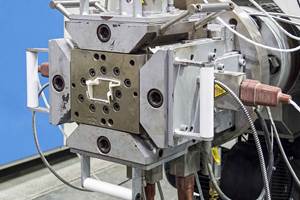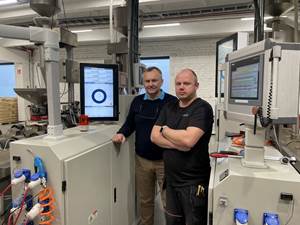How To Size & Calibrate Profile Parts
Doing it right is critical to maintaining profile dimensions.
Sizing is the term that refers to the handling of a profile as it exits the die and is subsequently shaped and cooled. Proper cooling is critical to maintain profile shape and size. In the early days of profile extrusion, the sizing techniques were crude, but over the past 40 years many good engineering principles have been applied to advance the technology.
FREE SIZING
One common sizing techniques used in profile extrusion is called free sizing. In free sizing, there are few or no constraints on the extrudate as it is cooled and shaped. A minimal amount of tooling is needed to size or hold the profile shape as it moves downstream. Elastomers such as flexible PVC, thermoplastic rubbers, TPOs, and TPUs are typically free sized. Polyurethanes, however, tend to stick and cling to ferrous metals, making string-up and sizing difficult. So the die designer must use very lubricous materials such as graphite, UHMW-HDPE, or some type of coating technology to overcome this issue.
Free sizing is typically used on simple profiles with equal walls, or on tubes and flat strips. As the profile exits the die lip, it runs into a water trough to help set the shape. The profile must enter the cooling trough quickly without dragging on the lip of the trough. The water trough should have linear bearings on the bed to allow for precise and smooth forward/backward motion to permit tank adjustment. Smooth up/down adjustment is also important for fine-tuning the water level on both the forward and aft sections of the tank.
In free sizing, water flow over the lip of the tank must be slow and steady. Water turbulence can cause the extrudate to vacillate in size and shape. Inlet water flow to the tank also should be steady and not create waves.
Most profile extruders utilize a series of water baths or divide the first water bath into compartments. The first compartment should have a steady flow of water to prevent waves, while the second compartment can have a more turbulent flow for enhanced cooling.
Free sizing for rigid thermoplastics employs techniques that differ from elastomers. Many thermoplastics, especially the higher-modulus, amorphous types, cannot tolerate high drawdown and orientation. The same is true for highly filled compounds, such as talc and calcium carbonate grades. Since high orientation (or drawdown) cannot be tolerated, the profile must set up as quickly as possible to prevent reduction in the overall dimensions and allow the desired shape and size to be achieved.
AIR-RACK & CALIBRATION SIZING
Two sizing techniques are common for simple shapes. The primary air-rack sizing system utilizes a series of support templates and convection fans located above and below the extrudate to cool and set the profile size and shape. Top templates and fingers or guides hold the shape while the profile travels downstream.
This system had been used for years on rigid thermoplastics, but was later replaced in high-volume production by calibration-style tooling. Today, use of air-rack sizing is confined to prototyping and short runs.
There are many disadvantages to the air-rack technique. Although inexpensive from a tooling-investment standpoint, this type of cooling compromises overall profile quality in production. The shape and size of the extrudate will change as the set point of cooling changes. The transition between the melt (or fusion) point and the set point is critical and must be maintained from a time and temperature standpoint, or the set point will change position. This will cause the shape and dimensions to change accordingly, creating scrap or defects. The critical set point to be reached to prevent further drawdown or size change is the Vicat softening point on engineering-grade thermoplastics, or the heat-distortion temperature (HDT) on amorphous resins.
Calibration sizing is the second commonly used technology. Here, the hot extrudate is shaped and cooled by surrounding static steel segments. The steel segments are internally cooled and designed to maximize cooling as the hot polymer passes across them.
The steel segments are also designed with a series of vacuum ports that pull the hot extrudate to the steel, enhancing the contact and thus the cooling.
CALIBRATION OPTIONS
There are three different styles of calibration: dry, wet, and combined style. Selecting the type that’s right for your process depends on the output rate you want to achieve.
Typical profile extrusions range in wall thickness from 1 to 3 mm. Line rates vary depending on the material, type and size of extruder, and the overall cross section of the profile.
Single-wall, non-hollow profiles can be cooled from both sides in a more efficient manner than hollow profiles. Hollow profiles require the use of wet calibration, and often differential calibration with a vacuum assist, to support the hollows and prevent collapsing.
Hollow profiles traditionally were sized and cooled with very long calibrators, sometimes exceeding 6 ft in length. But with escalating line rates it became impractical from a cost basis to size and cool this way. Plus, it required using long, robust pullers to overcome the drag forces.
Hollows can be only cooled from the outer walls at a specific rate. Heat transfer from the inner section reheats the outer wall, requiring additional sections to maintain the profile shape.
While the overall costs of calibration exceed other types of sizing for rigid profiles, that cost is saved by producing profiles with higher overall quality and less scrap.
Related Content
How to Effectively Reduce Costs with Smart Auxiliaries Technology
As drying, blending and conveying technologies grow more sophisticated, they offer processors great opportunities to reduce cost through better energy efficiency, smaller equipment footprints, reduced scrap and quicker changeovers. Increased throughput and better utilization of primary processing equipment and manpower are the results.
Read MoreIs Your Die Flow Changing Despite Following All the Correct Formulas?
Maybe the problem is that you're starting up with a dry die. Here are tips to solve this issue.
Read MoreOnline X-Ray Inspection Boosts Extrusion Quality
Höhle uses Sikora’s x-ray measuring systems for inline quality control of extruded microducts.
Read MoreHigh-Output Extruder Series Now Comes in Smaller Size
Series offers higher output, lower melt temperatures and energy savings.
Read MoreRead Next
People 4.0 – How to Get Buy-In from Your Staff for Industry 4.0 Systems
Implementing a production monitoring system as the foundation of a ‘smart factory’ is about integrating people with new technology as much as it is about integrating machines and computers. Here are tips from a company that has gone through the process.
Read MoreBeyond Prototypes: 8 Ways the Plastics Industry Is Using 3D Printing
Plastics processors are finding applications for 3D printing around the plant and across the supply chain. Here are 8 examples to look for at NPE2024.
Read MoreFor PLASTICS' CEO Seaholm, NPE to Shine Light on Sustainability Successes
With advocacy, communication and sustainability as three main pillars, Seaholm leads a trade association to NPE that ‘is more active today than we have ever been.’
Read More





















